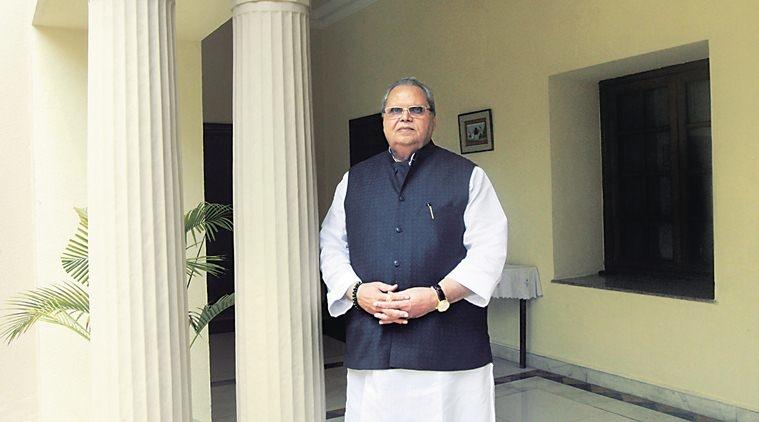J&K: Governor Malik’s Imposition of President’s Rule is Mired in Unconstitutionality

On November 21 evening, Governor Satya Pal Malik unexpectedly dissolved the state legislative assembly, shortly after the trio – People’s Democratic Party (PDP), National Conference (NC) and Congress – staked claim to form the government. As the end to the Governor’s rule was drawing to a close in December, attempts of government formation had gathered steam – the result of which was the decision of forming a “historic alliance” between NC and PDP.
It should be noted, that for the first time, two arch rivals – PDP and NC – aided by a national party, had staked claim to the government. However, the NC has maintained that they came together, not for the sake of governance, but to save the identity of Jammu and Kashmir, i.e. to preserve the sanctity of the beleaguered Articles 370 and 35A, which are being challenged in the Supreme Court. However, the J&K Assembly had been in a suspended animation since June, after the split in the PDP-BJP government earlier this year. Since last five months, the key parties, NC and PDP, have been demanding the dissolution of assembly, but to no avail.
The Governor’s decision of dissolution has put the state of Jammu and Kashmir, once again, in a state of political uncertainty, which the state has endured for decades. The Governor’s speedy decision to dissolve the state assembly was informed via a press communique. The communique was specific about the reasons for the decision. Three important reasons raised by Malik included, “extensive horse trading,” “coming together of opposing political ideologies,” and “longevity of the coalition.” These points take us back to the historic judgement in the 2016 Arunachal Pradesh ruling, where the Supreme court had clearly stated the ambit of power of the Governor.
In its judgement, the Supreme Court had underlined that what happens “within the four walls of a political party” is none of the Governor’s concern. Justice Khehar had then noted, “The Governor must remain aloof from any disagreement, discontent or dissension, within political parties. The activities within a political party, confirming turbulence, or unrest within the ranks, are beyond the concern of the Governor. The Governor must keep clear of horse trading, and even unsavoury political manipulations.” The Arunachal Pradesh ruling nullifies all the reasons given by the Governor Malik to dissolve the State Assembly.
Calling Governor’s decision an act of “political skulduggery”, aimed at subverting the process mandated by the Constitution, Sanjay Hegde, Senior Advocate in the Supreme Court said, “In a parliamentary democracy, it is perfectly both legal and legitimate for political parties with opposing ideologies to come together (as happened in Britain also during WWII, when the opposing factions of Churchill and Atlee joined hands), and the Governor has to satisfy a very high threshold of proof to substantiate his claims of horse-trading. Moreover, the state was already under Governor’s rule, and this was done to facilitate fresh elections. In the absence of elections being held, or the majority’s strength being tested on the floor of the House, this declaration of President’s rule stinks of illegality.” The material to substantiate that the governance of the state cannot be carried out in accordance with the Constitution is glaringly missing in this case, he continued.
Let’s have a look at the landmark case of S. R. Bommai v. Union of India that laid foundation for defining Governor’s rule. The case dealt with defining the powers of Centre with respect to Article 356 of the Constitution. Article 356 empowers the imposition of President’s rule in the state. The government of S.R. Bommai, who was the chief minister of Janata Dal government in Karnataka, was dismissed on April 21, 1989, and under the provision of Article 356, the President’s rule was imposed. The then Governor P. Venkatasubbiah had refused to give Bommai a chance to prove his majority even after his request, following which Bommai went to court, and challenged the Governor’s decision. Meanwhile, the government was dismissed.
In its historic judgement, on March 11, 1994, Supreme Court limited the scope of Article 356 of the Constitution. The court laid down conditions for the exercise of the article, and defined the roles of the Governor and the President. The Court had said, “The dissolution of Legislative Assembly is not a matter of course. It should be resorted to only where it is found necessary for achieving the purposes of the Proclamation.” It further said, “In case both Houses of Parliament disapprove or do not approve the Proclamation, the Proclamation lapses at the end of the two-month period. In such a case, the government which was dismissed revives. The legislative Assembly, which may have been kept in suspended animation gets reactivated.”
Dr. Faizan Mustafa, Vice Chancellor of NALSAR, Hyderabad, said, “It is beyond the power of the Governor to test whether the coalition enjoyed a majority, because that is for the Speaker to decide on the floor of the House. However, the slight problem in the case is Mehbooba Mufti did not give Malik a list of MLAs whose support she and her coalition enjoyed. She only sought time to present him with the list. In that case, at any rate, Malik ought to have waited for her to approach him, instead of prematurely ushering in President’s rule.”
Get the latest reports & analysis with people's perspective on Protests, movements & deep analytical videos, discussions of the current affairs in your Telegram app. Subscribe to NewsClick's Telegram channel & get Real-Time updates on stories, as they get published on our website.
























